
Concept explainers
(a)
Interpretation:
Given line structure is to be drawn using condensed formula.
Concept introduction:
The condensed formula indicates how the atoms should be connected in a given molecule. Each non-hydrogen atom is written explicitly followed immediately by the number of hydrogen atoms that are bonded to it. Multiple bonds are not shown explicitly in the condensed structure. To arrive at a total charge of zero, each carbon should have a maximum of four bonds while each oxygen should have a maximum of two bonds and two lone pairs. A parenthesis, in the condensed formula, represents that the repetitive unit is attached to the previous carbon atom. The
Answer to Problem 1.64P
For the given line structure, the condensed structure is:
![]()
Explanation of Solution
The given line structure is:
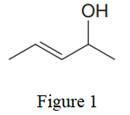
In the given line structure, there is a five carbon chain, with a carbon-carbon double bond and with a hydroxyl group. Each carbon atom is written explicitly followed immediately by the number of hydrogen atoms that are bonded to it. Multiple bonds are not shown explicitly in the condensed formula. Each carbon atom has a maximum of four bonds while each oxygen atom should have a maximum of two bonds. A parenthesis must be used for the carbon atom having three different groups attached. Thus, the hydroxyl group attached to the carbon atom must be shown in the parenthesis.
Thus, the condensed structure for the given line structure is:

The condensed structure for the given line structure is shown in Figure 2 above.
(b)
Interpretation:
Given line structure is to be drawn using condensed formula.
Concept introduction:
The condensed formula indicates how the atoms should be connected in a given molecule. Each carbon atom is written explicitly followed immediately by the number of hydrogen atoms that are bonded to it. To arrive at a total charge of zero, each carbon should have a maximum of four bonds while each oxygen should have a maximum of two bonds and two lone pairs. A parenthesis in the condensed formula represents that the repetitive unit is attached to the previous carbon atom. The
Answer to Problem 1.64P
For the given line structure, the condensed structure is:
![]()
Explanation of Solution
The given line structure is:
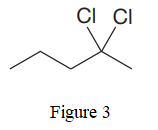
In the given line structure, there is a five carbon chain, with two chlorine atoms attached to one of the carbon atoms of the chain. Each carbon atom should have a maximum of four bonds while each oxygen atom should have a maximum of two bonds. A parenthesis must be used for the carbon atom having three different groups attached. Thus, the

The condensed structure for the given line structure is shown in Figure 4 above.
(c)
Interpretation:
Given line structure is to be drawn using condensed formula.
Concept introduction:
The condensed formula indicates how the atoms should be connected in a given molecule. Each non-hydrogen atom is written explicitly followed immediately by the number of hydrogen atoms that are bonded to it. Multiple bonds are not shown explicitly in the condensed structure. To arrive at a total charge of zero, each carbon should have a maximum of four bonds while each oxygen should have a maximum of two bonds and two lone pairs. A parenthesis in the condensed formula represents that the repetitive unit is attached to the previous carbon atom. The
Answer to Problem 1.64P
For the given line structure, the condensed structure is:
Explanation of Solution
The given line structure is:
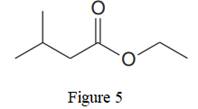
In the given line structure, there is a chain of four carbon atoms on the left side of a singly bonded oxygen. Each carbon atom is written explicitly followed immediately by the number of hydrogen atoms that are bonded to it. Multiple bonds are not shown explicitly in the condensed structure while an ethyl fragment is present at the right side of the singly bonded oxygen atom. The
Thus, the condensed structure for the given line structure is:

The condensed structure for the given line structure is shown in Figure 6 above.
(d)
Interpretation:
Given line structure is to be drawn using condensed formula.
Concept introduction:
The condensed formula indicates how the atoms should be connected in a given molecule. To arrive at a total charge of zero, each carbon should have a maximum of four bonds while each oxygen should have a maximum of two bonds and two lone pairs. A parenthesis in the condensed formula represents that the repetitive unit is attached to the previous carbon atom. Rings are generally now shown in their condensed formulas, but they are commonly shown in their partially condensed form. Multiple bonds in the ring and outside the ring are shows as they are. Parentheses are also used to clarify when two or three groups are attached to the same carbon atom.
Answer to Problem 1.64P
For the given line structure, the condensed structure is:
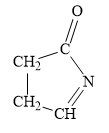
Explanation of Solution
The given line structure is:
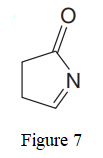
In the given line structure, a five membered ring containing a nitrogen atom is present. While writing a condensed formula, a ring is shown in its partial condensed formula. One of the carbon atoms in the ring forms a double bond with the oxygen atom which is shown as is.
Thus, the condensed structure for the given line structure is:
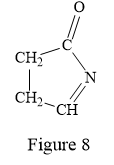
The condensed structure for the given line structure is shown in Figure 8 above.
(e)
Interpretation:
Given line structure is to be drawn using condensed formula.
Concept introduction:
The condensed formula indicates how the atoms should be connected in a given molecule. Each non-hydrogen atom is written explicitly, followed immediately by the number of hydrogen atoms that are bonded to it. Multiple bonds are not shown explicitly in the condensed structure. To arrive at a total charge of zero, each carbon should have a maximum of four bonds while each oxygen should have a maximum of two bonds and two lone pairs. A parenthesis in the condensed formula represents that the repetitive unit is attached to the previous carbon atom. Rings are generally shown in their condensed formulas, but they are commonly shown in their partially condensed form. Parentheses are also used to clarify when two or three groups are attached to the same carbon atom.
Answer to Problem 1.64P
For the given line structure, the condensed structure is:
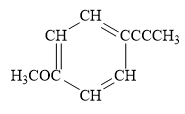
Explanation of Solution
The given line structure is:
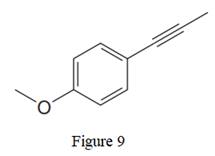
In the above line structure, the disubstituted benzene ring is present. One substituent of the benzene ring is a three carbon chain with an internal triple bond. The other substituent is a methoxy group,
Thus, the condensed structure for the given line structure is:
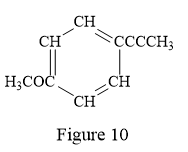
The condensed structure for the given line structure is shown in Figure 10 above.
(f)
Interpretation:
Given line structure is to be drawn using condensed formula.
Concept introduction:
The condensed formula indicates how the atoms should be connected in a given molecule. Each non-hydrogen atom is written explicitly, followed immediately by the number of hydrogen atoms that are bonded to it. To arrive at a total charge of zero, each carbon should have a maximum of four bonds while each oxygen should have a maximum of two bonds and two lone pairs. A parenthesis in the condensed formula represents that the repetitive unit is attached to the previous carbon atom. Rings are generally now shown in their condensed formulas, but they are commonly shown in their partially condensed form. Parentheses are also used to clarify when two or three groups are attached to the same carbon atom. A formal charge is shown explicitly on the atom.
Answer to Problem 1.64P
For the given line structure, the condensed structure is:
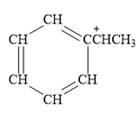
Explanation of Solution
The given line structure is:
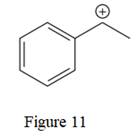
The above line structure is a structure for a cation. A carbocation is a carbon bearing a positive formal charge which is explicitly shown in the condensed formula. A six membered carbon ring with alternate double and single bonds is present and is shown as a partial condensed structure.
Thus, the condensed structure for the given line structure is:
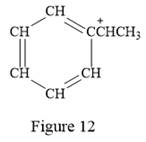
The condensed structure for the given line structure is shown in Figure 12 above.
(g)
Interpretation:
Given line structure is to be drawn using condensed formula.
Concept introduction:
The condensed formula indicates how the atoms should be connected in a given molecule. Each non-hydrogen atom is written explicitly, followed immediately by the number of hydrogen atoms that are bonded to it. To arrive at a total charge of zero, each carbon should have a maximum of four bonds while each oxygen should have a maximum of two bonds and two lone pairs. A parenthesis in the condensed formula represents that the repetitive unit is attached to the previous carbon atom. Rings are generally now shown in their condensed formulas, but they are commonly shown in their partially condensed form. Parentheses are also used to clarify when two or three groups are attached to the same carbon atom. A formal charge is shown explicitly on the atom.
Answer to Problem 1.64P
For the given line structure, the condensed structure is:
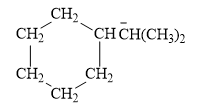
Explanation of Solution
The given line structure is:
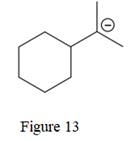
The above line structure is a structure for an anion. A six membered carbon ring with single bonds is present. Each carbon atom is written explicitly followed immediately by the number of hydrogen atoms that are bonded to it. The negative charge on the carbon atom is shown explicitly. The two methyl groups attached to the carbon bearing a negative charge are shown in the parenthesis.
Thus, the condensed structure for the given line structure is:
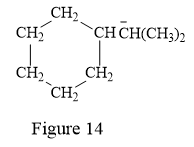
The condensed structure for the given line structure is shown in Figure 14 above.
(h)
Interpretation:
Given line structure is to be drawn using condensed formula.
Concept introduction:
The condensed formula indicates how the atoms should be connected in a given molecule. Each non-hydrogen atom is written explicitly, followed immediately by the number of hydrogen atoms that are bonded to it. To arrive at a total charge of zero, each carbon should have a maximum of four bonds while each oxygen should have a maximum of two bonds and two lone pairs. A parenthesis in the condensed formula represents that the repetitive unit is attached to the previous carbon atom. Rings are generally now shown in their condensed formulas, but they are commonly shown in their partially condensed form. Parentheses are also used to clarify when two or three groups are attached to the same carbon atom. A formal charge is shown explicitly on the atom.
Answer to Problem 1.64P
For the given line structure, the condensed structure is:
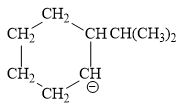
Explanation of Solution
The given line structure is:
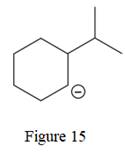
The above line structure is a six membered ring with a negative charge on one of the carbon atoms of the ring. The carbon bearing a negative charge is shown as is. The ring is monosubstituted with an isopropyl group. The two methyl groups in the isopropyl fragments is shown with the help of parenthesis.
Thus, the condensed structure for the given line structure is:
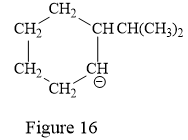
The condensed structure for the given line structure is shown in Figure 16 above.
(i)
Interpretation:
Given line structure is to be drawn using condensed formula.
Concept introduction:
The condensed formula indicates how the atoms should be connected in a given molecule. To arrive at a total charge of zero, each carbon should have a maximum of four bonds while each oxygen should have a maximum of two bonds and two lone pairs. A parenthesis in the condensed formula represents that the repetitive unit is attached to the previous carbon atom. The
Answer to Problem 1.64P
For the given line structure, the condensed structure is:
![]()
Explanation of Solution
The given line structure is:
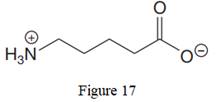
The above line structure is a chain of five carbon atoms. One end of the chain has carboxylate ion, in which the oxygen carries a negative charge. The other end of the chain has a nitrogen atom with three hydrogen atoms directly attached to it and carrying a positive charge. Formal charges on atoms are shown explicitly.
Thus, the condensed structure for the given line structure is:

The condensed structure for the given line structure is shown in Figure 18 above.
Want to see more full solutions like this?
Chapter 1 Solutions
Organic Chemistry: Principles And Mechanisms (second Edition)
- Identify the unknown compound from its IR and proton NMR spectra. C4H6O: 'H NMR: 82.43 (1H, t, J = 2 Hz); 8 3.41 (3H, s); 8 4.10 (2H, d, J = 2 Hz) IR: 2125, 3300 cm¹ The C4H6O compound liberates a gas when treated with C2H5 MgBr. Draw the unknown compound. Select Draw с H Templates Morearrow_forwardPlease help with number 6 I got a negative number could that be right?arrow_forward1,4-Dimethyl-1,3-cyclohexadiene can undergo 1,2- or 1,4-addition with hydrogen halides. (a) 1,2-Addition i. Draw the carbocation intermediate(s) formed during the 1,2-addition of hydrobromic acid to 1,4-dimethyl-1,3-cyclohexadiene. ii. What is the major 1,2-addition product formed during the reaction in (i)? (b) 1,4-Addition i. Draw the carbocation intermediate(s) formed during the 1,4-addition of hydrobromic acid to 1,4-dimethyl-1,3-cyclohexadiene. ii. What is the major 1,4-addition product formed from the reaction in (i)? (c) What is the kinetic product from the reaction of one mole of hydrobromic acid with 1,4-dimethyl-1,3-cyclohexadiene? Explain your reasoning. (d) What is the thermodynamic product from the reaction of one mole of hydrobro-mic acid with 1,4-dimethyl-1,3-cyclohexadiene? Explain your reasoning. (e) What major product will result when 1,4-dimethyl-1,3-cyclohexadiene is treated with one mole of hydrobromic acid at - 78 deg * C ? Explain your reasoning.arrow_forward
- Give the product of the bimolecular elimination from each of the isomeric halogenated compounds. Reaction A Reaction B. КОВ CH₂ HotBu +B+ ко HOIBU +Br+ Templates More QQQ Select Cv Templates More Cras QQQ One of these compounds undergoes elimination 50x faster than the other. Which one and why? Reaction A because the conformation needed for elimination places the phenyl groups and to each other Reaction A because the conformation needed for elimination places the phenyl groups gauche to each other. ◇ Reaction B because the conformation needed for elimination places the phenyl groups gach to each other. Reaction B because the conformation needed for elimination places the phenyl groups anti to each other.arrow_forwardFive isomeric alkenes. A through each undergo catalytic hydrogenation to give 2-methylpentane The IR spectra of these five alkenes have the key absorptions (in cm Compound Compound A –912. (§), 994 (5), 1643 (%), 3077 (1) Compound B 833 (3), 1667 (W), 3050 (weak shoulder on C-Habsorption) Compound C Compound D) –714 (5), 1665 (w), 3010 (m) 885 (3), 1650 (m), 3086 (m) 967 (5), no aharption 1600 to 1700, 3040 (m) Compound K Match each compound to the data presented. Compound A Compound B Compound C Compound D Compoundarrow_forward7. The three sets of replicate results below were accumulated for the analysis of the same sample. Pool these data to obtain the most efficient estimate of the mean analyte content and the standard deviation. Lead content/ppm: Set 1 Set 2 Set 3 1. 9.76 9.87 9.85 2. 9.42 9.64 9.91 3. 9.53 9.71 9.42 9.81 9.49arrow_forward
- Draw the Zaitsev product famed when 2,3-dimethylpentan-3-of undergoes an El dehydration. CH₂ E1 OH H₁PO₁ Select Draw Templates More QQQ +H₂Oarrow_forwardComplete the clean-pushing mechanism for the given ether synthesia from propanol in concentrated sulfurica140°C by adding any mining aloms, bands, charges, nonbonding electron pairs, and curved arrows. Draw hydrogen bonded to cayan, when applicable. ore 11,0 HPC Step 1: Draw curved arrows Step 2: Complete the intend carved Q2Q 56 QQQ Step 3: Complete the intermediate and add curved Step 4: Modify the structures to draw the QQQ QQQarrow_forward6. In an experiment the following replicate set of volume measurements (cm3) was recorded: (25.35, 25.80, 25.28, 25.50, 25.45, 25.43) A. Calculate the mean of the raw data. B. Using the rejection quotient (Q-test) reject any questionable results. C. Recalculate the mean and compare it with the value obtained in 2(a).arrow_forward
- A student proposes the transformation below in one step of an organic synthesis. There may be one or more reactants missing from the left-hand side, but there are no products missing from the right-hand side. There may also be catalysts, small inorganic reagents, and other important reaction conditions missing from the arrow. • Is the student's transformation possible? If not, check the box under the drawing area. • If the student's transformation is possible, then complete the reaction by adding any missing reactants to the left-hand side, and adding required catalysts, inorganic reagents, or other important reaction conditions above and below the arrow. • You do not need to balance the reaction, but be sure every important organic reactant or product is shown. + T G OH де OH This transformation can't be done in one step.arrow_forwardMacmillan Leaming Draw the major organic product of the reaction. 1. CH3CH2MgBr 2. H+ - G Select Draw Templates More H о QQarrow_forwardDraw the condensed structure of 3-hydroxy-2-butanone. Click anywhere to draw the first atom of your structure.arrow_forward
 ChemistryChemistryISBN:9781305957404Author:Steven S. Zumdahl, Susan A. Zumdahl, Donald J. DeCostePublisher:Cengage Learning
ChemistryChemistryISBN:9781305957404Author:Steven S. Zumdahl, Susan A. Zumdahl, Donald J. DeCostePublisher:Cengage Learning ChemistryChemistryISBN:9781259911156Author:Raymond Chang Dr., Jason Overby ProfessorPublisher:McGraw-Hill Education
ChemistryChemistryISBN:9781259911156Author:Raymond Chang Dr., Jason Overby ProfessorPublisher:McGraw-Hill Education Principles of Instrumental AnalysisChemistryISBN:9781305577213Author:Douglas A. Skoog, F. James Holler, Stanley R. CrouchPublisher:Cengage Learning
Principles of Instrumental AnalysisChemistryISBN:9781305577213Author:Douglas A. Skoog, F. James Holler, Stanley R. CrouchPublisher:Cengage Learning Organic ChemistryChemistryISBN:9780078021558Author:Janice Gorzynski Smith Dr.Publisher:McGraw-Hill Education
Organic ChemistryChemistryISBN:9780078021558Author:Janice Gorzynski Smith Dr.Publisher:McGraw-Hill Education Chemistry: Principles and ReactionsChemistryISBN:9781305079373Author:William L. Masterton, Cecile N. HurleyPublisher:Cengage Learning
Chemistry: Principles and ReactionsChemistryISBN:9781305079373Author:William L. Masterton, Cecile N. HurleyPublisher:Cengage Learning Elementary Principles of Chemical Processes, Bind...ChemistryISBN:9781118431221Author:Richard M. Felder, Ronald W. Rousseau, Lisa G. BullardPublisher:WILEY
Elementary Principles of Chemical Processes, Bind...ChemistryISBN:9781118431221Author:Richard M. Felder, Ronald W. Rousseau, Lisa G. BullardPublisher:WILEY





